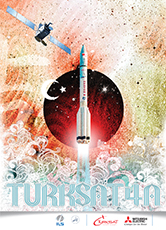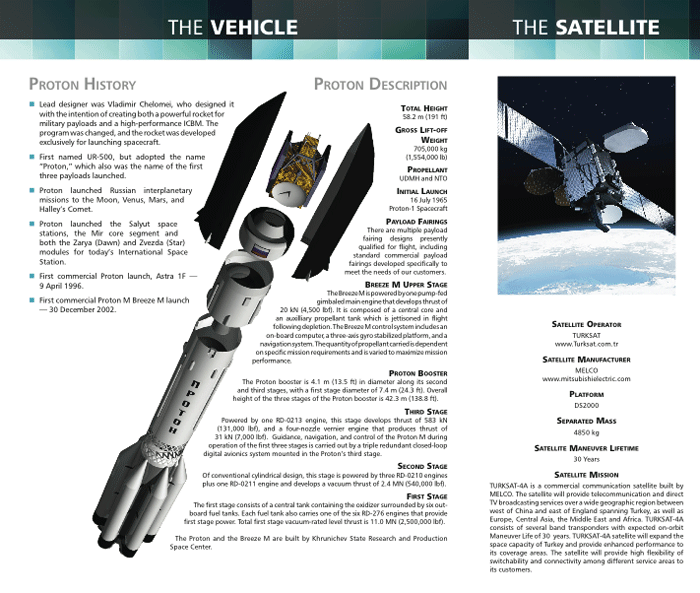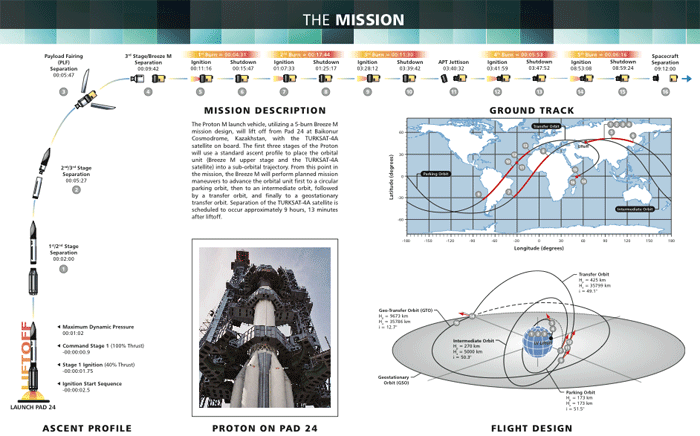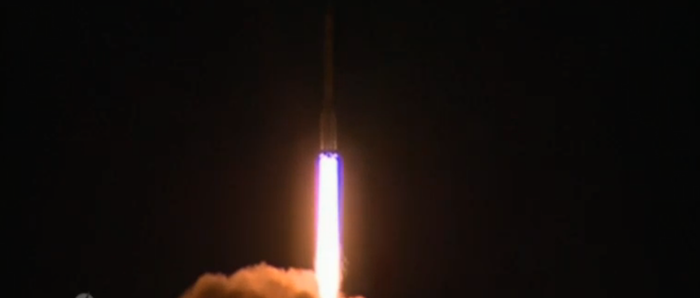.
13.10.2015

Payload:
TURKSAT-4B communications satellite
DS2000 Platform
Separated spacecraft mass: 4,924 kg
Launch Vehicle:
Proton M/Breeze M
705,000 kg (1,554,000 lb), including payload
58.2 m (191ft)
Launch Date:
17 October 2015 (GMT)
Launch Time:
02:40:11 Baikonur, 17 October 2015
05:40:11 Tokyo, 17 October 2015
16:40:11 ET, 16 October 2015
20:40:11 GMT, 16 October 2015
23:40:11 Turkey, 16 October 2015
Launch Site:
Baikonur Cosmodrome, Kazakhstan
Launch Pad 39
Satellite Operator:
TURKSAT, Turkey
Satellite Manufacturer:
Mitsubishi Electric Corporation, Japan
Launch Vehicle Manufacturer
Khrunichev State Research and Production Space Center, Russia
Launch Services Provider:
International Launch Services, USA
Satellite Use:
TURKSAT-4B is a commercial communication satellite built by Mitsubishi Electric. The satellite will provide telecommunication and direct TV broadcasting services over a wide geographic region between west of China and east of England spanning Turkey, as well as Europe, Central Asia, the Middle East and Africa. TURKSAT-4B will be positioned at 50 degrees east longitude and consists of multiple transponders with an expected on-orbit maneuver life of 30 years. TURKSAT-4B satellite will expand the space capacity of Turkey and provide enhanced performance to its coverage areas. The satellite will provide high flexibility of switchability and connectivity among different service areas to its customers.
Satellite Statistics:
_Mitsubishi Electric’s DS2000 platform
_36 transponders
_2084 MHz communications capacity
_Extensive coverage and connectivity over Turkey, Europe, Middle East, Asia and Africa
_Satellite Maneuver Lifetime: 30 years
Mission Profile:
The Proton M launch vehicle, utilizing a 5-burn Breeze M mission design, will lift off from Pad 39 at Baikonur Cosmodrome, Kazakhstan, with the TURKSAT-4B satellite on board. The first three stages of the Proton will use a standard ascent profile to place the orbital unit (Breeze M upper stage and the TURKSAT-4B satellite) into a sub-orbital trajectory. From this point in the mission, the Breeze M will perform planned mission maneuvers to advance the orbital unit first to a circular parking orbit, then to an intermediate orbit, followed by a transfer orbit, and finally to a geostationary transfer orbit. Separation of the TURKSAT-4B satellite is scheduled to occur approximately 9 hours, 13 minutes after liftoff.
Target Orbit at Separation:
Perigee: 9,281 km
Apogee: 35,786 km
Inclination: 13.2 degrees
Spacecraft Separation:
Approximately 9 hours, 13 minutes after liftoff
ILS Mission Statistics:
_4th ILS Proton Launch in 2015
_91st ILS Proton Launch Overall
_2nd TURKSAT Satellite Launched on ILS Proton
_2nd Mitsubishi Electric Satellite Launched on ILS Proton
Live Broadcast:
Live Coverage starting at 16:15 ET
Launch is scheduled for 16:40:11 ET
Webcast concludes no later than 17:00 ET
.


Quelle: ILS
---
Update: 16.10.2015
.
Russian Proton rocket with Turkish satellite to be launched at 20:40 GMT
It will be this year’s sixth launch of the Proton rocket and the 407th in its flight history
The launch of Russia’s Proton-M rocket with the Turkish satellite Turksat 4B is scheduled for 20:40 GMT from the Baikonur cosmodrome, the Khrunichev State Research and Production Space Centre - the producer of the rocket and Briz-M upper stage, told TASS on Friday.
According to the flight sequence, the first stage will be separated from the rocket 120 seconds after the blast-off and on the 327th second, payload fairing (PLF) covering the satellite during the flight through dense atmosphere will be jettisoned. On the 582nd second of the flight, the payload will reach the suborbital trajectory and will be placed on the target orbit by the Briz-M booster. The ascent mission duration will be 9 hours and 13 minutes.
The Turksat 4B satellite will be used to provide telecommunications services and has no military purpose.

Turksat-4B was built by Mitsubishi Electric. The satellite will provide telecommunication and direct TV broadcasting services over a wide geographic region between west of China and east of England spanning Turkey, as well as Europe, Central Asia, the Middle East and Africa. Turksat-4B will be positioned at 50 degrees east longitude and consists of multiple transponders with an expected on-orbit manoeuvre life of 30 years. Turksat-4B satellite will expand the space capacity of Turkey and provide enhanced performance to its coverage areas.
It will be this year’s sixth launch of the Proton rocket and the 407th in its flight history. The previous launch of the Proton rocket was carried out on September 14 this year with the Russian communications satellite Express AM8.
The next launch of the Proton-M rocket is preliminarily scheduled for December 20. This launch that will be carried out in the interests of the Russian Satellite Communications Company (RSCC) is to orbit the Express telecommunications satellite.
Quelle: TASS
-
Update: 17.10.2015
.
Turkish telecommunications satellite lifts off from Baikonur

A Russian Proton rocket boosted a Turkish telecommunications satellite into space Friday after a blazing liftoff from Kazakhstan, and a Breeze M upper stage injected the 5.4-ton broadcasting craft into an orbit ranging more than 20,000 miles above Earth nine hours later.
The Turksat 4B satellite — encapsulated in the nose cone of the 19-story Proton booster — blasted off at 2040:11 GMT (4:40:11 p.m. EDT) Friday from the Baikonur Cosmodrome, riding a column of orange rocket exhaust through low clouds hanging above the arid space center.
After pitching on a northeast trajectory from Baikonur, the Proton rocketed through the speed of sound and shed its six-engine first stage in the first two minutes of the flight.
The Proton’s second and third stage engines, all burning a noxious mixture of hydrazine and nitrogen tetroxide propellants, completed their programmed firings within 10 minutes, then deployed a battery-powered Breeze M space tug to guide Turksat 4B to its proper position in space.
An initial burn by the Breeze M’s main engine stabilized the spacecraft in a low-altitude parking orbit, and four more firings raised Turksat 4B’s altitude and move its orbit closer to the equator.
After the Breeze M’s fifth burn, the upper stage was scheduled to release Turksat 4B at 0553 GMT (1:53 a.m. EDT) Saturday.
Produced by Khrunichev State Research and Production Space Center, the Proton/Breeze M vehicle will target deployment of Turksat 4B in an elliptical orbit with a high point of 22,236 miles (35,786 kilometers), a low point of 5,767 miles (9,281 kilometers), and an inclination angle of 13.2 degrees to the equator.
The mission’s target orbit numbers were published by International Launch Services, the Proton’s U.S.-based marketing and sales firm. ILS confirmed the successful deployment of Turksat 4B early Saturday.
Quelle: SN
4667 Views
